The Canadian dollar is the official currency of Canada since the country’s independence in 1867.
Compare rates at 80 currency stores in 34 cities
Its symbol and at the same time ISO 4217 code is CAD. It is also written with the symbol $, or Can$ or C$, to differentiate it from the US dollar. But you have to know that if you go to Canada, their currency is known there simply as “dollar”.
As of the date of this update, in April 2023, the euro to Canadian dollar exchange rate in the foreign exchange market (note, not the banknote) is:
- 1 euro = 1.47 CAD.
- 1 Canadian dollar = 0.68 euros
History of the Canadian dollar
The origins of this coin date back to colonial times.
In the mid-19th century, the provinces and territories that now make up Canada began using their own currencies against the British pound, following the example of the US dollar.
Compare rates at 80 currency stores in 34 cities
The first Canadian dollars were minted in the Quebec region by the Bank of Montreal in 1817.
The process of adopting the Canadian dollar as the official single currency of the new country occurred in parallel to the process of independence that began in 1867.
Finally, in 1871 the definitive enactment of the Uniform Currency Act took place. And with it the adoption of the dollar as the official currency of Canada.
The Bank of Canada, based in the country’s capital, Ottawa, has been the sole body responsible for issuing the national currency since 1934, although only in the case of banknotes. For their part, Canadian dollar coins are minted by the Royal Canadian Mint.
Canadian dollar coins
The Canadian dollar is divided into 100 cents, cents or “cents”.
The following denominations of cents and dollars minted by the Canadian Mint are currently in circulation in the country:
- Cent coins: 5, 10, 25 and 50 cents (symbol ¢).
- Dollar coins: 1 dollar ($1) and two dollars ($2).
Cent coins
In Anglophone Canada, specific denominations are used for each currency and its value:
- The 5¢ coin is known as a nickel.
- At 10¢ he is called dime.
- At 25¢ quarter.
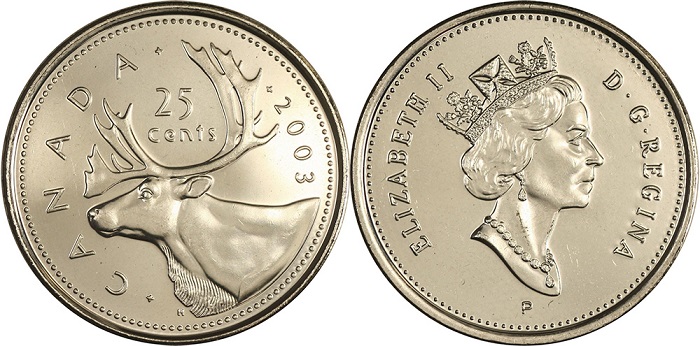
25 Canadian dollar cents coins
- The 50¢ coin is called a piece. The latter is barely minted, so its value is increasingly scarce.
1 Dollar coin
- The 1 CAD coin is known as a loonie. It was baptized that way because the figure of a typical aquatic bird of the country called “loon” appears on its reverse.
- Similarly, the 2 CAD coin is called a toonie or twoonie, meaning “double loonie”.
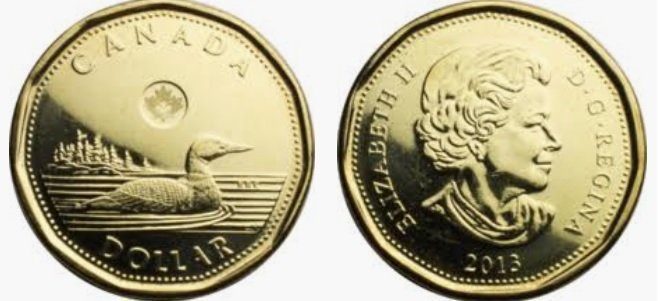
1 Canadian dollar coin
The standard design of the Canadian dollar uses national symbols (generally referring to natural life) for the reverse, while the obverse is still reserved for the effigy of Queen Elizabeth II of England, since Canada is part of the Commonwealth.
Canadian dollar banknotes
The Bank of Canada has notes in circulation in denominations of 5, 10, 20, 50 and 100 Canadian dollars.
Other denominations of dollar notes in circulation in Canada, although rare, are $1, $2, $25, $500 and $1,000. These denominations officially ceased to circulate in Canada in January 2021. From that date they can be exchanged for other banknotes at Bank of Canada offices.
All the inscriptions that appear on these banknotes are written in the two official languages of the country: English and French.
The material of the current CAD banknotes is composed of a synthetic polymer that replaced the old cotton fiber paper in 2011. The first Canadian banknotes were issued in 1935. Since then there have been eight series, the last in the year 2018.
Canada 5 dollar note
The blue 5 CAD note features a portrait of Sir Wilfrid Laurier (1841-1919), Prime Minister of Canada between 1896 and 1911, along with the original West Block tower of Parliament (1865).
Laurier was elected to the House of Commons in 1874. He remained a Member of Parliament for 45 consecutive years and was Leader of the Liberal Party for 32 of them. Laurier was Canada’s first French-speaking prime minister.
He was a master of the art of constructive compromise and a passionate advocate for national unity. His administrations promoted national development and expansion, encouraging immigration from Europe and the United States to western Canada.
He also supported the construction of a second transcontinental railway and coordinated the incorporation into Canada of the provinces of Alberta and Saskatchewan and the Yukon Territory.
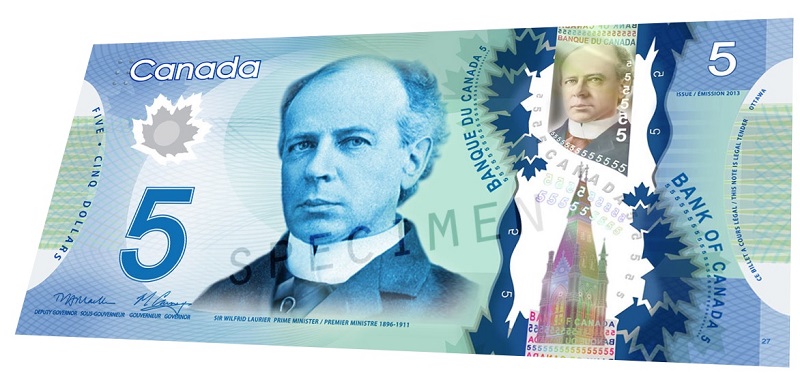
5 Canadian dollar polymer banknote 5 CAD (front)
An astronaut and several space modules appear on the reverse in commemoration of Canada’s contribution to the International Space Station (ISS) program. Specifically, Canadarm2 appears, a robotic arm 17 meters long for the assembly and maintenance of the station.
In the background you can see the Earth from space from images from Natural Resources Canada. Specifically, you can see the Great Lakes, Hudson Bay and the Gulf of Saint Lawrence.
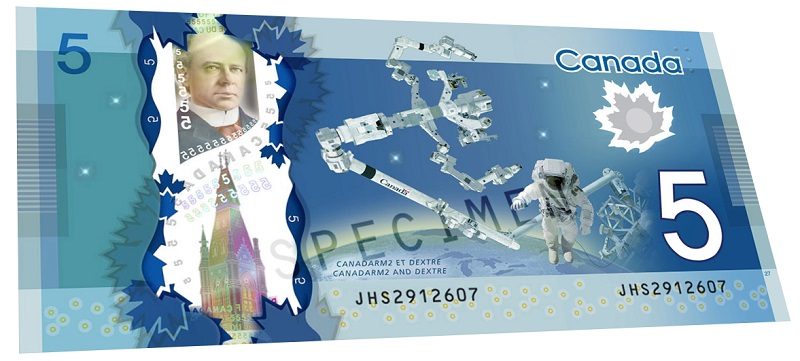
5 Canadian dollar polymer banknote 5 CAD (back)
EThe counter value in Spain, February 2023, of a Canadian 5 dollar banknote is 3.65 euros.
Canada 10 dollar note
This banknote is the first of the eighth series of 2018 to date. It has the outstanding peculiarity of its vertical configuration.
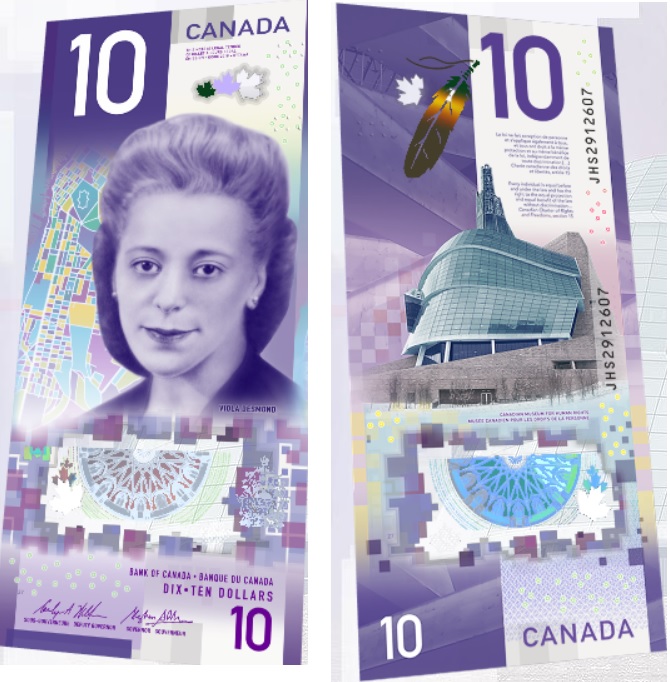
Vertical 10 CAD Viola Desmond Note of 2018
Predominantly in purple and violet colours, this innovative banknote shows on its front the figure of Viola Desmond (1914-1965), a Canadian activist who fought against racial segregation during the last century.
This is the first banknote in the history of the country in which the portrait of a prime minister or a member of the British royal family does not appear, except for a woman. On the reverse is the Winnipeg Museum for Human Rights.
The IBNS, a non-profit organization that promotes the study of banknotes, gave this banknote the first prize for the banknote with the best aesthetic and practical design in 2018, ahead of the 500 Mexican peso banknote, which was a finalist.
The banknotes of the current series (pending the release of the rest of the “vertical” series) have as their main themes the history, heritage and culture of Canada.
They are the first CAD banknotes made with polymer, so they are cleaner (since they do not absorb sweat, oil and other liquids) and more durable.
The color of each banknote corresponds to a certain value: blue for the 5 CAD note, purple for the 10 CAD note, green for the 20 CAD note, red for the 50 CAD note and finally brown for the banknote of 100 CAD.
This is what the previous $10 banknote looked like, dedicated to John A. Mcdonald, one of the “fathers” of Canadian independence.
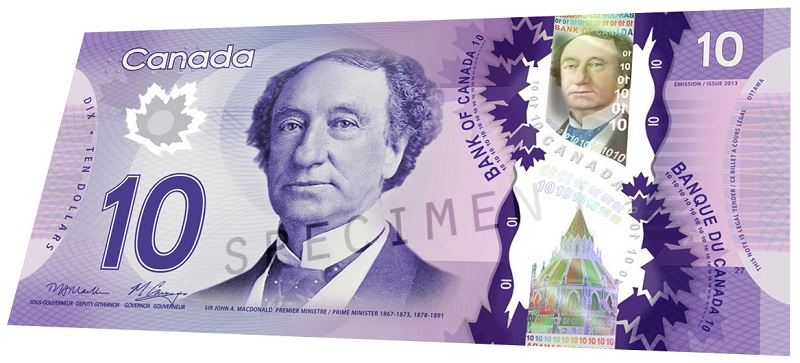
10 Canadian dollar banknote 10 CAD (front)
On the reverse is an image of Le Canadien (The Canadian), the train that crosses the country from coast to coast. Railroad expansion in Canada peaked in the 1880s.
For Canadians this was and still is an engineering milestone for a young country with varied and difficult terrain to practice (through the Canadian Rockies, the “Canadian Rockies”).
At the time this was the longest rail route ever built, and its completion demonstrated Canada’s pioneering spirit across its eastern and western borders, connecting people and facilitating the exchange of goods.
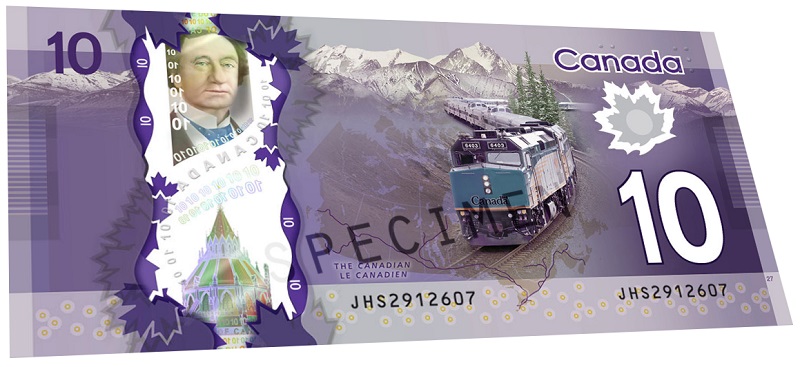
10 Canadian dollar banknote 10 CAD (back)
The equivalent value in Spain, April 2023, of a Canadian $10 banknote is 7.31 euros.
Canada 20 dollar banknote
The green 20 Canadian dollar banknote (20 CAD) is decorated with the image of Queen Elizabeth II on the obverse next to a reproduction of the Peace Tower/Tour de la Paix building in Ottawa.
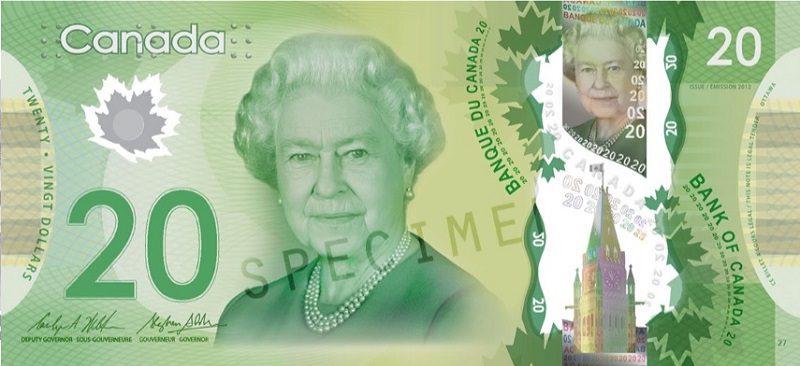
Obverse of the 20 canadian dollars banknote (20 CAD)
On the reverse is the Canadian National Vimy Memorial, the monument in memory of Canadians who have fought in different wars throughout the country’s history, and specifically the Battle of Vimy Ridge.
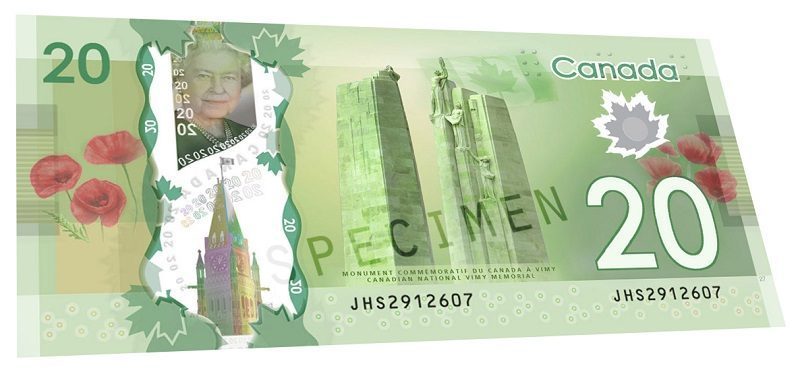
Reverse of the 20 canadian dollars banknote (20 CAD)
There is also a waving Canadian flag and some red poppies, whose color contrasts with the dominant green of the note.
In April 1917, the four divisions of the Canadian Corps fought together for the first time and took Vimy Ridge, after several failed attempts by the other Allied forces. But the success of this conquest came at a high cost to Canada: nearly 3,600 Canadians were killed and another 7,000 wounded.
Victory at Vimy was not only crucial in ending World War I, it brought Canada’s coming of age, giving a young nation a sense of confidence and identity. De Vimy, Canadian Brigadier General A.E. Ross commented: “in those few minutes I witnessed the birth of a nation”.
The equivalent value in Spain, April 2023, of a Canadian $20 note is 14.61 euros.
Canada 50 dollar banknote
The red 50 CAD note features a portrait of William Lyon Mackenzie King (1874-1950), who served as Prime Minister of Canada for two periods: 1921-1930 and 1935-1948. Next to it is the building of Parliament Hill, the parliament of Canada.
William Lyon Mackenzie King presided over some of the most transformative moments in Canadian history: independence from the United Kingdom; the Second World War; the introduction of unemployment insurance in 1940 and family allowances in 1944.
He was also active in the United Nations and the League of Nations. The Canadian Citizenship Act was also introduced under the King government in 1947. Prior to its introduction, “Canadians” were considered British subjects rather than Canadian citizens.
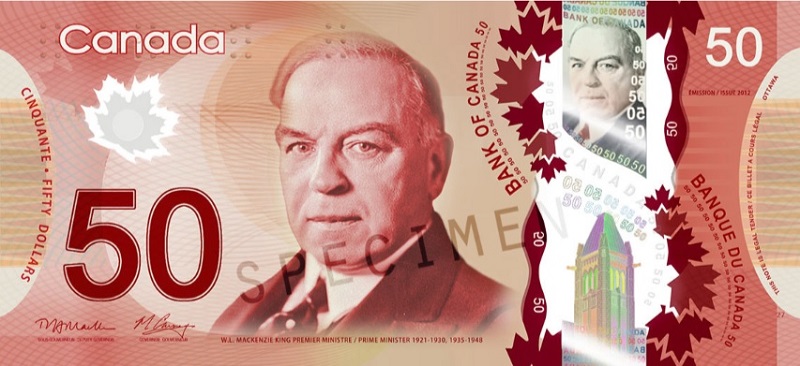
Obverse of the 50 canadian dollars banknote (50 CAD)
Several images appear on the reverse: the Amundsen ship, a Canadian Coast Guard icebreaker, a text in the Inuit alphabet that corresponds to the word “Arctic” and a background that consists of a map of the north of the country. Its value is approximately 33 euros.
The Amundsen became a research icebreaker in 2003. Previously, she was known as the CCGS Sir John Franklin. The icebreaker was modified in 2002 by a consortium of universities and government agencies and relaunched as the Amundsen, a state-of-the-art research vessel.
Jointly operated by ArcticNet and the Canadian Coast Guard, the Amundsen has the ability to travel 15,000 nautical miles before returning to port, sometimes remaining at sea for more than a full year.
One of the ship’s unique features is its ‘moon pool’, an opening in the underside of the ship that allows scientists to deploy instruments like a remotely operated vehicle to explore the depths of the Arctic Ocean, even with the ship surrounded by thick sea ice.
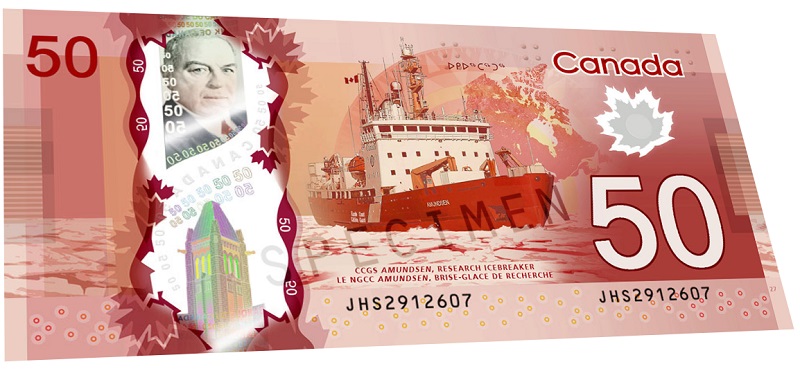
Reverse of the 50 canadian dollars banknote (50 CAD)
The equivalent value in Spain, April 2023, of a Canadian $50 banknote is €36.54.
Canada 100 dollar note
This brown-toned banknote bears the effigy of Sir Robert Borden (1854-1937), the eighth Prime Minister of Canada, on the obverse.
It fell to him to lead the country (8 million citizens) during World War I, and to answer for the 66,000 casualties on the front lines and 172,000 Canadian wounded.
Canada’s expensive contribution to the war effort (it sent 650,000 people to the battlefield) led to independent representation at the 1919 Paris Peace Conference and in the League of Nations.
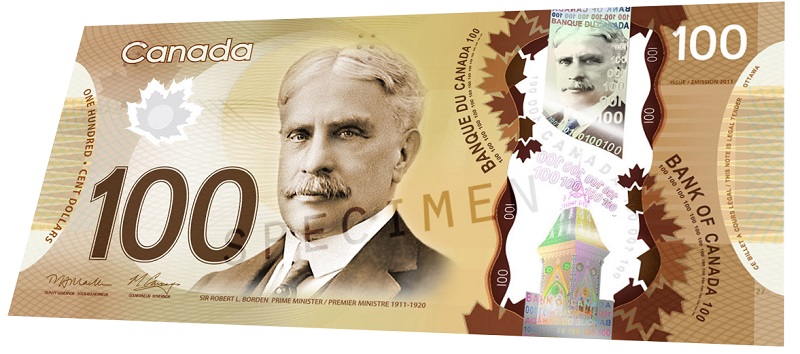
100 Canadian dollar polymer banknote 100 CAD (front)
On the reverse is the East Block tower of Parliament, a shining example of the Gothic Revival style, built in 1860 and a researcher in honor of health research in the country.
Not in vain, Canada has brought humanity the discovery of insulin for the treatment of diabetes in 1921, or the pacemaker of the heart by John Hopps in 1950.
Insulin is one of Canada’s best-known medical innovations. The image of the insulin bottle on the note dates from 1923.
Frederick Banting and Charles Best were two Canadian medical researchers who discovered in 1921 that insulin could be used to treat diabetes. Insulin continues to save millions of lives today.
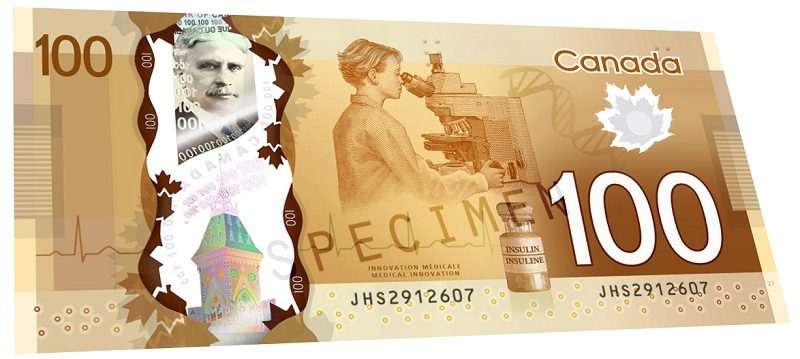
100 Canadian dollar polymer banknote 100 CAD (back)
At the bottom left you can also see the trace of the electrocardiogram, another of Canada’s contributions to heart health (in addition to John Hopps’ pacemaker in 1950).
In the 1940s, Dr. Wilfred G. Bigelow and Dr. John C. Callaghan were Canadian cardiac surgeons working on cold heart surgery techniques.
While experimenting, they discovered that applying a small electrical charge to the heart would stimulate it to beat and, when done regularly, could keep it beating at the correct rate. Bigelow and Callaghan then enlisted electrical engineer John Hopps to build a device, the world’s first pacemaker in 1950.
The equivalent value in France, February 2023, of a Canadian $100 banknote is 73.70 euros.
Euro to Canadian dollar rate
The exchange rate of the euro against the Canadian dollar is quite stable, although it fluctuates slightly on an ongoing basis. If you search Google for “Euro to Canadian dollar rate” you will find dozens of websites (“currency converters”) that offer a “price” of the day.
For example, you will see this type of chart with the rates of that currency pair from a coverter like XE. Something like this (February 22, 2023).
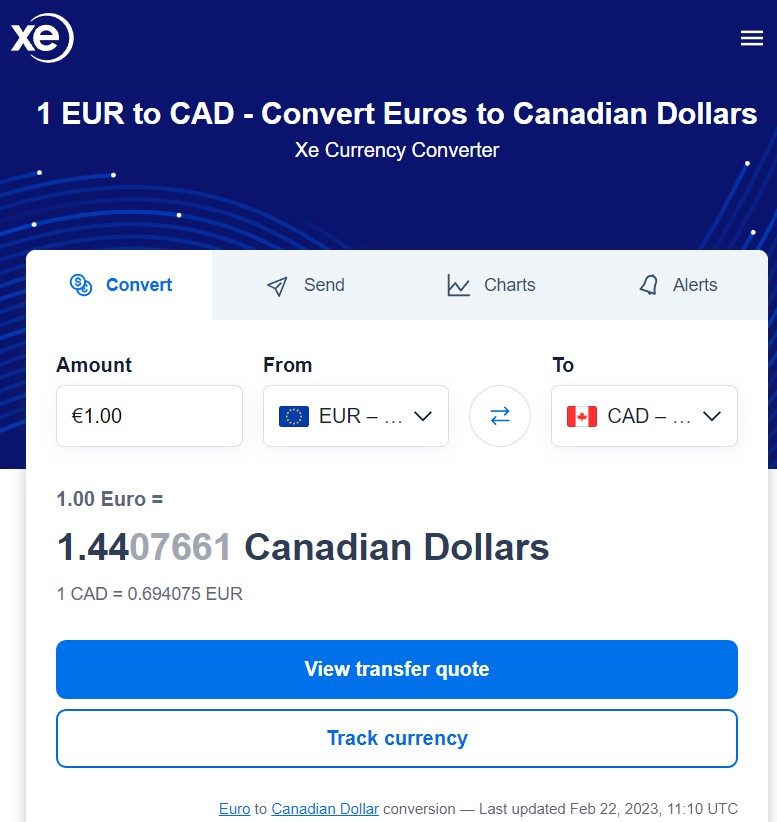
Eur to CAD rate XE 22 02 2023
As you can see, the exchange rate today is 1 euro equals 1.44 CAD, but keep in mind that this graph represents the value of the Canadian dollar “currency” against the euro, and not that of real currency (in banknotes), which is lower.
In fact, at currency suppliers in Spain you can buy Canadian dollars as of the date of this update (Feb 2023) at an exchange rate of around 1.10 (expensive places like the airport) and 1.33 CAD most favorable of Cambiator.es for each euro.
Nothing to do with the Euro to Canadian dollar currency exchange shown at the currency converters.
So, when you see these values in Google and other currency converters with your mobile, you should keep in mind the following:
- This is an unofficial price, and therefore not reliable. That is, if you click on the “Disclaimer” link, you get this warning from XE:“We use the mid-market rate for our Converter. This is for informational purposes only. You won’t receive this rate when sending money”
- These prices that you see are usually wholesale prices of the Canadian dollar currency against the euro currency (currency and currency are not the same).
- This price can only be obtained by banks among themselves, that is, it is impossible to obtain it as an individual. In fact, it is known as the interbank exchange rate.
If you need Canadian dollars in banknotes, you will have to go through the retail banknote market (bank or currency supplier). This market means that Canadian dollars have had to be “transported” by someone for you to enjoy them (or bought from travelers from Canada, previously passing through Spain).
In other words, moving banknotes from one place to another has logistical costs that will make its sale price more expensive (the exchange rate that whoever sells it will apply to you).
The Canadian dollar is not a very abundant currency/currency in Spain. As a result of its relative scarcity, its price is more expensive in Spain than in Canada. If you decide to buy Canadian dollars in Spain, it is good to anticipate the purchase and order them online to get a better price.
Where to exchange Canadian dollars
The two most popular places to exchange Canadian dollars in Spain are banks and currency suppliers, high street or the airport.
Of these, the least recommended place to buy is the airport and any business that charges you a commission in addition to an “exchange margin” (difference between the price for which the currency was paid and the price for which it is sold to you).
Buy or sell Canadian dollars at the airport
In Spain there are two major airports through which to travel to Canada: Madrid-Barajas and Barcelona-El Prat.
The manager of these airports, AENA, is putting out to tender a concession for several years to banks or currency suppliers that may be interested in managing foreign exchange.
In both cases, the Spanish currency supplier Global Exchange is the one who manages this service. They have bright and colorful exchange offices where they provide great service practically 24 hours a day. Its employees speak several languages and exchange up to 70 currencies for you. But they have a but and that is that their exchange prices are absolutely abusive.
Much of the blame lies with the very high fees that AENA requires the currency supplier to pay, for which it has to buy or sell foreign currency with very wide margins that will mean that you receive very few Canadian dollars for your euros and, at the same time, conversely, very few euros if you have dollars left over when you return to Spain.
Buy or sell Canadian dollars at your bank
Banks are the first place we think of when exchanging euros to Canadian dollars.
All the big banks in Spain change them for you, but all of them charge you a margin on the change (lower than at the airport) and a commission of around 2.5 – 3% of the amount changed with a minimum of 10 to 15 euros.
This means that, if you exchange 1,000 euros into Canadian dollars with them, they will keep around 30 euros in commission and exchange the euro for a dollar for only 970 euros.
Buy or sell Canadian dollars in cheap currency suppliers
Currency suppliers outside the airport usually have (with some rare exceptions) cheaper exchange rates and in some cases they do not charge you a commission in addition to an exchange rate.
Cambiator helps you find, every day, the best option so that your trip to Canada is much more productive.
Euro to Canadian dollar exchange rate today
To find out the euro to Canadian dollar exchange rate and save a lot of money, the best thing you can do is use our currency comparator. It’s free for you and it will only take you 1 minute to find the best option:
- Buy Canadian dollars with euros (EUR-CAD)
- Sell your Canadian dollars for euros (CAD-EUR)
Other popular currencies
Best rate of the day (exchange euros to another currency)

Sin comentarios